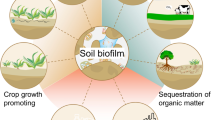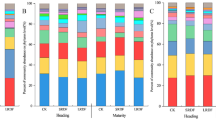Abstract
Leachate and reclaimed wastewater have become the important sources of polycyclic aromatic hydrocarbons in soils. However, the information on bioremediation of leachate and reclaimed wastewater-contaminated soils is still lacking. Identification of changes in microbial structure or of enriched genera related to biodegradation could aid identification of particular organisms or consortia capable of degrading polycyclic aromatic hydrocarbons in these contaminated soils. In this study, terminal restriction fragment length polymorphism, coupled with 16S Ribosomal ribonucleic acid clone library analysis, was applied to investigate the composition of bacterial community in leachate-contaminated soil or grassland soil irrigated reclaimed wastewater and the response to phenanthrene amendment. Results showed that phenanthrene amendment had significant but different impacts on microbial community structure, dependent on soil source. Several greatly enriched terminal restriction fragments with phenanthrene biodegradation were identified. Moreover, genus rhizobacteria, possibly linked to phenanthrene biodegradation, was firstly reported in this study. This work might provide some new insights into bioremediation of polycyclic aromatic hydrocarbons-contaminated soils.
Similar content being viewed by others
References
Abdulsalam, S.; Bugaje, I. M.; Adefila, S. S.; Ibrahim S., (2011). Comparison of biostimulation and bioaugmentation for remediation of soil contaminated with spent motor oil. Int. J. Environ. Sci. Tech., 8(1), 187–194 (8 pages).
Andreoni, V.; Cavalca, L.; Rao, M. A.; Nocerino, G.; Bernasconi, S.; Dell’Amico, E.; Colombo, M.; Gianfreda, L., (2004). Bacterial communities and enzyme activities of PAHs polluted soils. Chemosphere, 57(5), 401–412 (12 pages).
Arulazhagan, P.; Vasudevan, N.; Yeom, I. T., (2010). Biodegradation of polycyclic aromatic hydrocarbon by a halotolerant bacterial consortium isolated from marine environment. Int. J. Environ. Sci. Tech., 7(4), 639–652 (14 pages).
Cébron, A.; Beguiristain, T.; Faure, P.; Norini, M. P.; Masfaraud, J. F.; Leyval, C., (2009). Influence of vegetation on the in situ bacterial community and polycyclic aromatic hydrocarbon (PAH) degraders in aged PAH-contaminated or thermal-desorption-treated soil. Appl. Environ. Microbiol., 75(19), 6322–6330 (9 pages).
Chang, Y. T.; Lee, J. F.; Chao, H. P., (2007). Variability of communities and physiological characteristics between free-living bacteria and attached bacteria during the PAH biodegradation in a soil/water system. Eur. J. Soil Biol., 45(3), 283–296 (14 pages).
Chen, Y.; Wang, C. X.; Wang, Z. J., (2005). Residues and source identification of persistent organic pollutants in farmland soils irrigated by effluents from biological treatment plants. Environ. Int., 31(6), 778–783 (6 pages).
Clarke, K. R.; Warwick, R. M., (2001). Change in marine communities: an approach to statistical analysis and interpretation, 2nd ed. PRIMER-E, Plymouth Marine Laboratory, Plymouth, UK, 172 pp.
Clement, B. G.; Kehl, L. E.; DeBord, K. L.; Kitts, C. L., (1998). Terminal restriction fragment patterns (TRFPs), a rapid, PCR-based method for the comparison of complex bacterial communities. J. Microbiol. Methods, 31(3), 135–142 (8 pages).
Cunliffe, M.; Kertesz, M. A., (2006). Effect of Sphingobium yanoikuyae B1 inoculation on bacterial community dynamics and polycyclic aromatic hydrocarbon degradation in aged and freshly PAH-contaminated soils. Environ. Pollut., 144(1), 228–237 (10 pages).
Cupples, A. M.; Sims, G. K., (2007). Identification of in situ 2,4-dichlorophenoxyacetic acid-degrading soil microorganisms using DNA-stable isotope probing. Soil Biol. Biochem., 39(1), 232–238 (7 pages).
Dunbar, J.; Ticknor, L. O.; Kuske, C. R., (2000). Assessment of microbial diversity in four southwestern United States soils by 16S rRNA gene terminal restriction fragment analysis. Appl. Environ. Microbiol., 66(7), 2943–2950 (18 pages).
Dunbar, J. M.; Ticknor, L. O.; Kuske, C. R., (2001). Phylogenetic specificity and reproducibility and new method for analysis of terminal restriction fragment profiles of 16S rRNA genes from bacterial communities. Appl. Environ. Microbiol., 67(1), 190–197 (8 pages).
Duran, A. C.; Gonzailez, A., (2009). Determination of lead, naphthalene, phenanthrene, anthracene and pyrene in street dust. Int. J. Environ. Sci. Tech., 6(4), 663–670 (8 pages).
Falk, M. W.; Song, K. G.; Matiasek, M. G.; Wuertz, S., (2009). Microbial community dynamics in replicate membrane bioreactors-natural reproducible fluctuations. Water. Res., 43(3), 842–852 (11 pages).
Gennaro, P. D.; Morenoa, B.; Annonib, E.; García-Rodríguez, S.; Bestetti, G.; Beniteza, E., (2009). Dynamic changes in bacterial community structure and in naphthalene dioxygenase expression in vermicompost-amended PAH-contaminated soils. J. Hazard. Mater., 172(2–3), 1464–1469 (6 pages).
Grant, R. J.; Muckian, L. M.; Clipson, N. J. W.; Doyle, E. M., (2007). Microbial community changes during the bioremediation of creosote-contaminated soil. Lett. Appl. Microbiol., 44(3), 293–300 (8 pages).
Hackl, E.; Zechmeister-Boltenstern, S.; Bodrossy, L.; Sessitsch, A., (2004). Comparison of diversities and compositions of bacterial populations inhabiting natural forest soils. Appl. Environ. Microbiol., 70(9), 5057–5065 (9 pages).
Han, X. J.; Li, L. Q.; Pan, G. X.; Hu, Z. L., (2009). Pollution characteristics of polycyclic aromatic hydrocarbons in soils from farmland around the domestic refuse dump. Eco. Environ. Sci., 18(4), 1251–1255 (5 pages).
Haritash, A. K.; Kaushik, C. P., (2009). Biodegradation aspects of polycyclic aromatic hydrocarbons (PAHs): A Rev. J. Hazard. Mater., 169(1–3), 1–15 (15 pages).
He, J. J., (2008). Study on PAHs degraders and microbial diversity analysis in petroleum-contaminated soil. M.Sc. thesis, Xinjiang Agricultural University.
He, J. T.; Jin, A. F.; Chen, S. N.; Wei, Y. X., (2010). Distribution characteristics of soil PAHs in reclaimed water irrigation area in the southeastern suburb of Beijing. J. Agro-Environ. Sci., 29(4), 666–673 (8 pages).
Huang, Y.; Zhang, S. Y.; Lv, M. J.; Xie, S. G., (2010). Biosorption characteristics of ectomycorrhizal fungal mycelium to anthracene. Biomed. Environ. Sci., 23(5), 167–172 (6 pages).
Langworthy, D. E.; Stapleton, R. D.; Sayler, G. S.; Findlay, R. H., (1998). Genotypic and phenotypic responses of a riverine microbial community to polycyclic aromatic hydrocarbon contamination. Appl. Environ. Microbiol., 64(9), 3422–3428 (7 pages).
LeBlanc, L. A.; Gulnick, J. D.; Brownawell, B. J.; Taylor, G. T., (2006). The influence of sediment resuspension on the degradation of phenanthrene in flow-through microcosms. Mar. Environ. Res., 61(2), 202–223 (22 pages).
Liu, W. T.; Marsh, T. L.; Cheng, H.; Forney, L. J., (1997). Characterization of microbial diversity by determining terminal restriction fragment length polymorphisms of genes encoding 16S rRNA. Appl. Environ. Microbiol., 63(11), 4516–4522 (7 pages).
Luo, C.; Xie, S. G.; Sun, W.; Li, X.; Cupples, A. M., (2009). Identification of a novel toluene-degrading bacterium from the candidate phylum TM7, as determined by DNA stable isotope probing. Appl. Environ. Microbiol., 75(13), 4644–4647 (4 pages).
MacNaughton, S. J.; Stephen, J. R.; Venosa, A. D.; Davis, G. A.; Chang, Y. J.; White, D. C., (1999). Microbial population changes during bioremediation of an experimental oil spill. Appl. Environ. Microbiol., 65(8), 3566–3574 (9 pages).
Marsh, T. L., (1999). Terminal restriction fragment length polymorphism (T-RFLP): An emerging method for characterizing diversity among homologous populations of amplification products. Curr. Opin. Microbiol., 2(3), 323–327 (5 pages).
Mills, D. K.; Fitzgeralda, K.; Litchfielda, C. D.; Gillevetb, P. M., (2003). A comparison of DNA profiling techniques for monitoring nutrient impact on microbial community composition during bioremediation of petroleum-contaminated soils. J. Microbiol. Methods., 54(1), 57–74 (18 pages).
Mu, D. Y.; Scow, K. M., (1994). Effect of trichloroethylene (TCE) and toluene concentrations on TCE and toluene biodegradation and the population density of TCE and toluene degraders in soil. Appl. Environ. Microbiol., 60(7), 2661–2665 (5 pages).
Muckian, L. M.; Grant, R. J.; Clipson, N. J. W.; Doyle, E. M.,(2009). Bacterial community dynamics during bioremediation of phenanthrene- and fluoranthene-amended soil. Int. Biodeterior. Biodegrad., 63(1), 52–56 (5 pages).
Nautiyal, C. S.; Govindarajan, R.; Lavania, M.; Pushpangadan, P., (2008). Novel mechanism of modulating natural antioxidants in functional foods: Involvement of plant growth promoting rhizobacteria NRRL B-30488. J. Agric. Food. Chem., 56(12), 4474–4481 (8 pages).
Nwuche, C. O.; Ugoji, E. O., (2010). Effect of co-existing plant specie on soil microbial activity under heavy metal stress. Int. J. Environ. Sci. Tech., 7(4), 697–704 (8 pages).
Piskonen, R.; NyyssÖnen, M.; Rajamäki, T.; Itävaara, M., (2005). Monitoring of accelerated naphthalene-biodegradation in a bioaugmented soil slurry. Biodegradation, 16(2), 127–134 (8 pages).
Santos, E. C.; Jacques, R. J. S.; Bento, F. M.; do Carmo, R.; Peralba, M.; Selbach, P. A.; Flá, S.; Camargo, F. A. O., (2008). Anthracene biodegradation and surface activity by an iron-stimulated Pseudomonas sp. Bioresour. Tech., 99(7), 2644–2649 (6 pages).
Schütte, U. M. E.; Abdo, Z.; Bent, S. J.; Shyu, C.; Williams, C. J.; Pierson, J. D.; Forney, L. J., (2008). Advances in the use of terminal restriction fragment length polymorphism (T-RFLP) analysis of 16S rRNA genes to characterize microbial communities. Appl. Microbiol. Biotech., 80(3), 365–380 (16 pages).
Stralis-Pavese, N.; Bodrossy, L.; Reichenauer, T. G.; Weilharter, A.; Sessitsch, A., (2006). 16S rRNA based T-RFLP analysis of methane oxidizing bacteria-Assessment, critical evaluation of methodology performance and application for landfill site cover soils. Appl. Soil. Ecol., 31(3), 251–266 (16 pages).
Straube, W. L.; Nestler, C. C.; Hansen, L. D.; Ringleberg, D.; Pritchard, P. H.; Jones-Meehan, J., (2003). Remediation of polyaromatic hydrocarbons (PAHs) through landfarming with biostimulation and bioaugmentation. Acta. Biotech., 23(2–3), 179–196 (18 pages).
Subramanyam, B. M. E.; Das, A., (2009). Linearized and non-linearized isotherm models comparative study on adsorption of aqueous phenol solution in soil. Int. J. Environ. Sci. Tech., 6(4), 633–640 (8 pages).
Tao, S.; Cui, Y. H.; Xu, F. L.; Li, B. G.; Cao, J.; Liu, W. X.; Schmitt, G.; Wang, X. J.; Shen, W. R.; Qing, B. P.; Sun, R., (2004). Polycyclic aromatic hydrocarbons (PAHs) in agricultural soil and vegetables from Tianjin. Sci. Total. Environ., 320(1), 11–24 (14 pages).
Törneman, N.; Yang, X. H.; Bååth, E.; Bengtsson, G., (2008). Spatial covariation of microbial community composition and polycyclic aromatic hydrocarbon concentration in a creosote-polluted soil. Environ. Toxicol. Chem., 27(5), 1039–1046 (8 pages).
Vinãs, M.; Sabaté, J.; Espuny, M. J.; Solanas, A. M., (2005). Bacterial community dynamics and polycyclic aromatic hydrocarbon degradation during bioremediation of heavily creosote-contaminated soil. Appl. Environ. Microbiol., 71(11), 7008–7018 (11 pages).
Wang, Q.; Garrity, G. M.; Tiedje, J. M.; Cole, J. R., (2007). Naïve Bayesian classifier for rapid assignment of rRNA sequences into the new bacterial taxonomy. Appl. Environ. Microbiol., 73(16), 5261–5267 (7 pages).
Whyte, L. G.; Bourbonniere, L.; Bellerose, C.; Greer, C. W., (1999). Bioremediation assessment of hydrocarbon-contaminated soils from the high arctic. Bioremed. J., 3(1), 69–79 (11 pages).
Wiinsche, L.; Briiggemann, L.; Babel, W., (1995). Determination of substrate utilization patterns of soil microbial communities: An approach to assess population changes after hydrocarbon pollution. FEMS Microbiol. Ecol., 17(4), 295–306 (12 pages).
Wong, J. W. C.; Lai, K. M.; Wan, C. K.; Ma, K. K.; Fang, M., (2002). Isolation and optimization of PAH-degradative bacteria from contaminated soil for PAHs bioremediation. Water Air Soil Pollut., 139(1–4), 1–13 (13 pages).
Xie, S. G.; Sun, W. M.; Luo, C. L.; Cupples, A. M., (2010). Stable isotope probing identifies novel m-xylene degraders in soil microcosms from contaminated and uncontaminated sites. Water, Air, Soil Pollut., 212(1–4), 113–122 (10 pages).
Yousefi Kebria, D.; Khodadadi, A.; Ganjidoust, H.; Badkoubi, A.; Amoozegar, M. A., (2009). Isolation and characterization of a novel native Bacillus strain capable of degrading diesel fuel. Int. J. Environ. Sci. Tech., 6(3), 435–442 (8 pages).
Yuan, S. Y.; Wei, S. H.; Chang, B. V., (2000). Biodegradation of polycyclic aromatic hydrocarbons by a mixed culture. Chemosphere, 41(9), 1463–1468 (6 pages).
Zhang, H.; Dang, Z.; Zheng, L. C.; Yi, X. Y., (2009). Remediation of soil co-contaminated with pyrene and cadmium by growing maize (Zea mays L.) Int. J. Environ. Sci. Tech., 6(2), 249–258 (10 pages).
Zhang, W.; Wang, H.; Zhang, R.; Yu, X. Z.; Qian, P. Y.; Wong, M. H., (2010). Bacterial communities in PAH contaminated soils at an electronic-waste processing center in China. Ecotoxicology, 19(1), 96–104 (9 pages).
Zhang, Y. L., (2008). Ecologieal effects of the utilization of sewage and sewage sludge on microbes in soil. Ph.D. thesis, Shandong University.
Author information
Authors and Affiliations
Corresponding author
Rights and permissions
About this article
Cite this article
Zhang, S.Y., Wang, Q.F. & Xie, S.G. Microbial community changes in contaminated soils in response to phenanthrene amendment. Int. J. Environ. Sci. Technol. 8, 321–330 (2011). https://doi.org/10.1007/BF03326219
Received:
Revised:
Accepted:
Published:
Issue Date:
DOI: https://doi.org/10.1007/BF03326219




